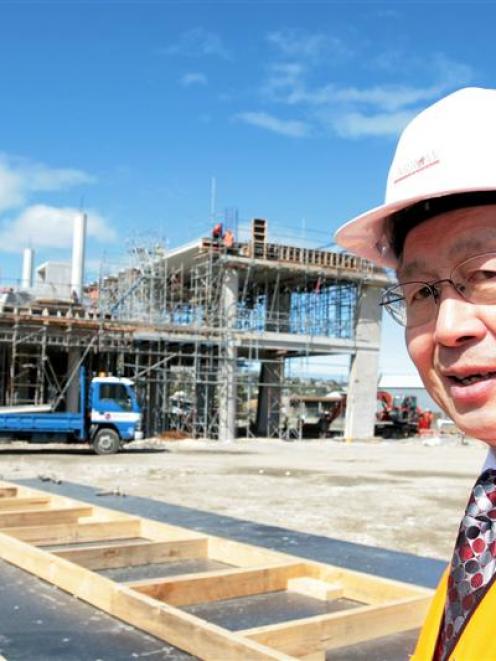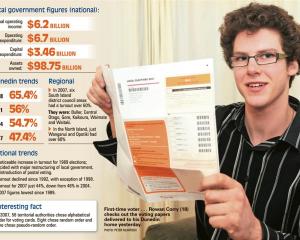
Why should this be? I don't know, but it could be that the incumbent mayor and council are either unaware, lazy, or have been captivated by what is euphemistically termed "bureaucratic spin".
I say this as a number of significant developments have taken, and are taking place in this city, with far-reaching implications for the welfare and financial health of its citizens.
Further, they are all, without exception, projects which have been, and are being driven by either bureaucracy or unelected bodies.
Take the controversial stadium for instance.
This is arguably the most contentious and expensive proposition put to citizens in the city's history.
The promulgation of this was delegated to the Carisbrook Stadium Trust (CST) which unilaterally made the decision that instead of recommending upgrading Carisbrook, there would be a new stand-alone structure located at Awatea St.
It was announced that the stadium would cost not a cent more than $188 million, and that there would be no call on ratepayers to fund it.
Council applauded this initiative and gave it full support.
And by funding all development costs it gave the first lie to the CST's claim.
From then on, council was fed a controlled flow of information, misinformation, obfuscation and plain old humbug.
Through all of this, council was manipulated, cajoled and mesmerised into agreeing to the funding of what had now escalated to a more than $200 million project.
The rest is history in the making.
The town hall/conference centre is another case in point.
Totally conceived by staff, promoted at $14 million, escalated to $18 million, at which point it was stated that it would result in an additional 8 conferences a year with economic benefits of $3.5 million per annum.
Then, at $29.32 million, Kate Styles stated there would be an additional 16.2 conferences with economic benefits of some $16 million per annum.
In the latest issue of City Talk, Kate Styles claims: "The business case showed clearly that the conferences and events will bring in the revenue that will support the performance and community side of the venue."
This is in support of the latest cost of $45 million.
Ask her to detail the "business case" and she repeatedly avoids the request.
The council has, over the years, received these reports based on nothing but anecdotal evidence, and has approved the escalating costs without demur.
Several years ago, when I challenged council on this project, I was dismissed by Cr John Bezett as one of those unfortunate people who knew the cost of everything but the value of nothing.
The controversial parking issue is now a hot subject.
Developed by staff as the "DCC Parking Strategy", council states: "Cost, supply and location of parking, can all be used to contribute to environmental sustainability through demand management - reducing the supply of parking, increasing its cost, or locating further from the trip destination can all reduce the demand for parking, making alternative travel modes more attractive, relative to driving."
This is classic bureaucrat-speak if ever there was.
Did councillors read this before going along with the implementation of the fiasco we now have? Do they not see by the public and business outcry that this policy could destroy the inner city business fabric?Rubbish collection/recycling has come up for revision.
Why? We don't really know.
We only know that the preferred option we are supposed to endorse will cost an additional $70 per annum per household, with no perceivable benefits.
Again, did council ask the hard questions here? Isn't this where council should take the initiative and demand that staff clarify their actions?Another situation which has seemingly slipped under the radar disturbs me greatly.
It was announced a few weeks ago that Graeme Lowe Otago tannery-fellmongery in Green Island was to close with a loss of 60 jobs.
This is an operation which has existed under various ownerships for longer than I can remember.
Why did it close? We don't know.
Nor, I suspect do any councillors.
One would suppose it is to do with the financial viability of the operation.
Perhaps costs have overwhelmed the operation.
But the most egregious aspect of this could be in the announcement (ODT 10.9.09) that DCC's water and waste services business unit has suffered a budget blowout of up to $7 million over 10 years, due to the closure of the tannery.
It transpires that it was charged $703,606 per annum for the service provided.
This was offset by a saving of $147,000 due to the service no longer being required.
The net loss will be $556,000 per annum.
That represents a whopping profit margin of 380%! What on earth is going on here? Does council want to know? Could it be that the more than $500,000 a year of excess costs to the client brought about the closure? Did council think to ask? Does the loss of 60 jobs not warrant investigation? How can a department operate like this? What checks and balances are there? Isn't that what an elected council is for? To oversee and govern in a reasonable and responsible way.
When a council abrogates its responsibilities, bureaucracy steps in, fills the vacuum, assumes authority, and if it is beset with the mediocre talent we have, financial anarchy reigns.
Time for some serious soul searching, I think. - Calvin Oaten



